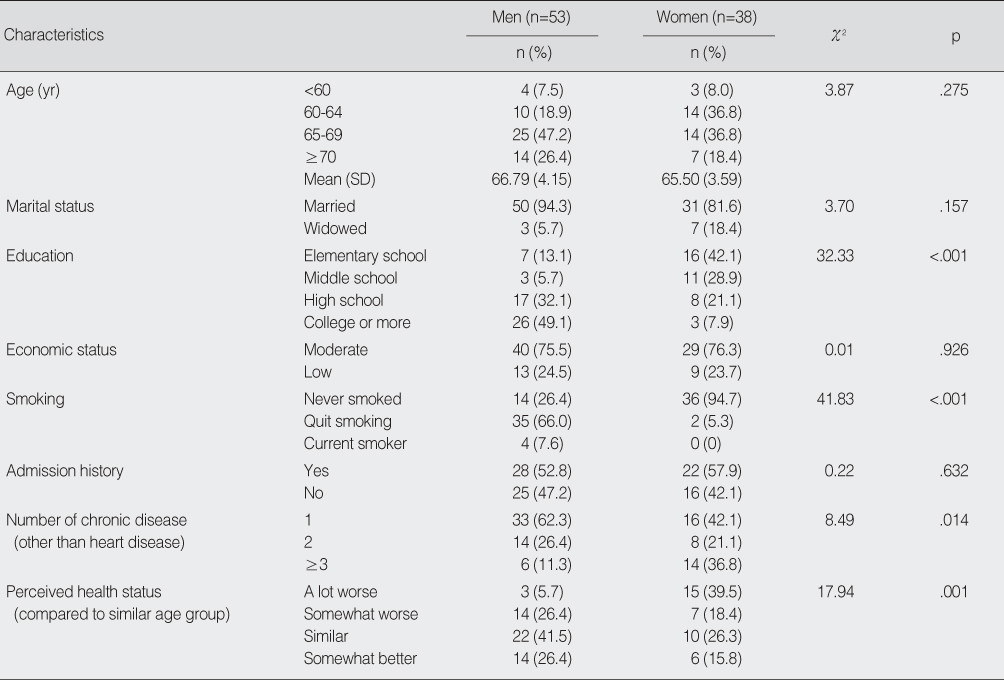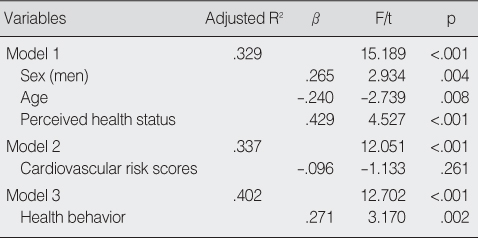Articles
- Page Path
- HOME > J Korean Acad Nurs > Volume 38(6); 2008 > Article
-
Original Article
- Factors explaining Quality of Life in Individuals with Coronary Artery Disease
- In Sook Park, Rhayun Song, Sukhee Ahn, Hee Young So, Hyun Li Kim, Kyung Ok Joo
-
Journal of Korean Academy of Nursing 2008;38(6):866-873.
DOI: https://doi.org/10.4040/jkan.2008.38.6.866
Published online: December 31, 2008
1Professor, Department of Nursing, Chungnam National University, Daejeon, Korea.
2Associate professor, Department of Nursing, Chungnam National University, Daejeon, Korea.
3Assistant professor, Department of Nursing, Chungnam National University, Daejeon, Korea.
4Researcher, Department of Nursing, Chungnam National University, Daejeon, Korea.
- Address reprint requests to: Song, Rhayun. Department of Nursing, Chungnam National University, 6 Munwha 1-dong, Jung-gu, Daejeon 301-747, Korea. Tel: 82-42-580-8831, Fax: 82-42-584-8915, songry@cnu.ac.kr
Copyright © 2008 Korean Society of Nursing Science
Abstract
-
Purpose
- The study was done to compare quality of life by gender, and to identify factors which explain quality of life in individuals with coronary artery disease.
-
Methods
- For the survey, 91 individuals (53 men and 38 women) agreed to participate in the study. Cardiovascular risk factors, systolic blood pressure, body mass index, total cholesterol, triglyceride, high density lipoprotein-cholesterol, and low density lipoprotein-cholesterol, health behavior as well as quality of life, were measured. Descriptive statistics, t-test, correlation and hierarchical multiple regression with SPSS WIN 12.0 were used to analyze the data.
-
Results
- Significant gender differences were found for education, smoking status, chronic disease, perceived health status, and quality of life within sub-dimensions. Hierarchical regression analysis showed gender (men), age, perceived health status, cardiovascular risk scores, and health behaviors together explained 40.2% (adjusted R2) of variance in quality of life.
-
Conclusion
- As the factors explaining quality of life in individuals with coronary artery disease have been identified as gender (men), age, perceived health status, and health behaviors, health promotion programs designed for this population should focus on these factors for effective behavioral modification, and consequent improvement in quality of life.
- 1. Borenstein M, Rothstein H, Cohen J. Power and precision. 1997;Mahwah, NJ, Lawrence Erlbaum Associates.
- 2. Ferrans CE, Powers MJ. Psychometric assessment of the quality of life index. Research in Nursing and Health. 1992;15:29–38.ArticlePubMed
- 3. Ferrans CE, Zerwic JJ, Wilbur JE, Larson JL. Conceptual model of health-related quality of life. Journal of Nursing Scholarship. 2005;37:336–342.ArticlePubMed
- 4. Frattaroli J, Weidner G, Merritt-Worden TA, Frenda S, Ornish D. Angina pectoris and atherosclerotic risk factors in the multi-site cardiac lifestyle intervention program. The American Journal of Cardiology. 2008;101:911–918.ArticlePubMed
- 5. Frijling BD, Lobo CM, Keus IM, Jenks KM, Akkermans RP, Hulscher ME, et al. Perceptions of cardiovascular risk among patients with hypertension or diabetes. Patient Education and Counseling. 2004;52:47–53.ArticlePubMed
- 6. Höfer S, Doering S, Rumpold G, Oldridge N, Benzer W. Determinants of health-related quality of life in patients with coronary artery disease. European Journal of Cardiovascular Prevention and Rehabilitation. 2006;13:398–406.ArticlePubMed
- 7. Johansson P, Brostrom A, Dahlström U, Alehagen U. Global perceived health and ten-year cardiovascular mortality in elderly primary care patients with possible heart failure. European Journal of Heart Failure. 2008;10:1040–1047.ArticlePubMed
- 8. Jo HS, Kim KJ. The effects of a cardiac rehabilitation program on health behavior compliance, cardiovascular function, and quality of life for the patients with ischemic heart disease. Journal of Korean Academy of Nursing. 2000;30:560–570.ArticlePDF
- 9. Koertge J, Weidner G, Elliott-Eller M, Scherwitz L, Merritt-Worden TA, Marlin R, et al. Improvement in medical risk factors and quality of life in women and men with coronary artery disease in the Multicenter Lifestyle Demonstration Project. The American Journal of Cardiology. 2003;19:1316–1322.
- 10. 2005 Health behavior and chronic disease statistics. Korea Centers for Disease Control and Prevention. 2008;Retrieved 2008 Aug 12, 2008. from http://www.cdc.gov/nchs/fastats/heart.htm.
- 11. Korea National Statistical Office. Yearly report for the causes of mortality. 2006;Seoul, Korea National Statistical Office.
- 12. Lee EH, Moon SM, Tahk SJ, Kim SH. Quality of life in patients with chronic cardiovascular disease. Journal of Korean Academy of Adult Nursing. 2007;19:12–23.
- 13. Lee EH, Tahk SJ, Shin JH, Lee YW, Song RY. Development and a psychometric evaluation of cardiovascular disease-specific quality of life scale for Koreans. Journal of Korean Academy of Nursing. 2007;37:313–323.ArticlePubMedPDF
- 14. Lee EH, Tahk SJ, Song YS. Analyses of the studies on cardiovascular disease-specific quality of life reported in Korea. Journal of Korean Academy of Adult Nursing. 2005;17:5–21.
- 15. Maddigan SL, Majumdar SR, Johnson JA. Understanding the complex association between patient-provider relationships, self-care behaviors, and health-related quality of life in type 2 diabetes: A structural equation modeling approach. Quality of Life Research. 2005;14:1489–1500.PubMed
- 16. Michalsen A, Grossman P, Lehmann N, Knoblauch NT, Paul A, Moebus S, et al. Psychological and quality of life outcomes from a comprehensive stress reduction and lifestyle program in patients with coronary artery disease: Results of a randomized trial. Psychotherapy and Psychosomatics. 2005;74:344–352.ArticlePubMedPDF
- 17. Pischke CR, Weidner G, Elliott-Eller M, Sherwitz L, Merritt-Worden TA, Marlin R, et al. Comparison of coronary risk factors and quality of life in coronary artery disease patients with versus without diabetes mellitus. The American Journal of Cardiology. 2006;97:1267–1273.ArticlePubMed
- 18. Shephard RJ, Franklin B. Changes in the quality of life: A major goal of cardiac rehabilitation. Journal of Cardiopulmonary Rehabilitation. 2001;21:189–200.ArticlePubMed
- 19. Song R, June KJ, Kim CG, Jeon MY. Comparisons of motivation, health behaviors, and functional status among elders in residential homes in Korea. Public Health Nursing. 2004;21:361–371.ArticlePubMed
- 20. Song RY, Lee HJ. Effects of the inpatient cardiac rehabilitation program on behavioral modification and quality of life in patients with coronary artery disease. Journal of Korean Academy of Nursing. 2000;30:463–475.ArticlePDF
- 21. Toobert DJ, Strycker LA, Glasgow RE, Barrera M, Bagdade JD. Enhancing support for health behavior change among women at risk for heart disease: The mediterranean lifestyle trial. Health Education Research. 2002;17:574–585.ArticlePubMed
- 22. Vaccarino V, Lin ZQ, Kasl SV, Mattera JA, Roumanis SA, Abramson JL, et al. Sex differences in health status after coronary artery bypass surgery. Circulation. 2008;108:2642–2647.Article
- 23. World Health Organization. Prevention of cardiovascular disease: Guidelines for assessment and management of cardiovascular risk. 2007;Geneva, Switzerland, World Health Organization.
REFERENCES
Figure & Data
REFERENCES
Citations

- Prediction Model for Health-related Quality of Life in Coronary Artery Disease Patients According to Stress Level
Minju Kim, Ju Youn Choi
Journal of Korean Academy of Fundamentals of Nursing.2025; 32(3): 320. CrossRef - Health-Related Quality of Life Based on Comorbidities Among Patients with End-Stage Renal Disease
Jieun Cha, Dallong Han
Osong Public Health and Research Perspectives.2020; 11(4): 194. CrossRef - The Effects of Smart Program for Patients Who Underwent Percutaneous Coronary Intervention (SP-PCI) on Disease-Related Knowledge, Health Behavior, and Quality of Life: A Non-Randomized Controlled Trial
Jueun Lee, Haejung Lee
Journal of Korean Academy of Nursing.2017; 47(6): 756. CrossRef - Predictors of health-promoting behaviors in Taiwanese patients with coronary artery disease
Ai-Fu Chiou, Shu-Pen Hsu, Huei-Fong Hung
Applied Nursing Research.2016; 30: 1. CrossRef - Effects of position change on lumbar pain and discomfort of Korean patients after invasive percutaneous coronary intervention: a RCT study
Nam Hyun Cha, Sohyune Sok
Journal of Physical Therapy Science.2016; 28(10): 2742. CrossRef - Influencing Effects of Type D Personality on Symptom Experiences and Quality of Life in Patients with Percutaneous Coronary Intervention
Eun Hee Jo, Sun Hee Han, Myung Ha Lee, Sung Reul Kim
Korean Journal of Adult Nursing.2016; 28(5): 536. CrossRef - Relationships of Depression Symptom, Self-Esteem, and Stress to Health-Related Quality of Life in Patients with Hypertension Registered to a Community Health Center
Mi Ni Choi, Eun-Hyun Lee
Journal of Korean Public Health Nursing.2015; 29(2): 165. CrossRef - Development and Evaluation of a Self Care Education Program for Elderly Patients with Percutaneous Coronary Intervention
Gyeong-Jin Jo, Jin-Hyang Yang
The Journal of Korean Academic Society of Nursing Education.2014; 20(2): 266. CrossRef - The Health Behavioral Experience of Patients with Myocardial Infarction during the Recovery Period
Kyung Ja Kang, Moon Jeong Kim
Korean Journal of Adult Nursing.2014; 26(2): 203. CrossRef - Effects of Tai Chi Exercises on Cardiovascular Risks, Recurrence Risk, and Quality of Life in Patients with Coronary Artery Disease
Rha Yun Song, Moon Kyoung Park, Jin-Ok Cheong, Jae-Hyeong Park, In-Whan Seong
Korean Journal of Adult Nursing.2013; 25(5): 515. CrossRef - Teaching Experience of Tai Chi Instructors with Nursing Background
In Sook Park, Rhayun Song
Journal of muscle and joint health.2013; 20(1): 10. CrossRef - Postoperative Quality of Life in Patients with Papillary Thyroid Cancer
Ju-Sung Kim
Journal of the Korea Academia-Industrial cooperation Society.2011; 12(3): 1260. CrossRef - Assessment of nurses' nutritional knowledge regarding therapeutic diet regimens
K.A. Park, W.I. Cho, K.J. Song, Y.S. Lee, I.S. Sung, S.M. Choi-Kwon
Nurse Education Today.2011; 31(2): 192. CrossRef - Comparison of Cardiovascular Health Status and Health Behaviors in Korean Women based on Household Income
Young-Joo Park, Nah-Mee Shin, Ji-Won Yoon, Jiwon Choi, Sook-Ja Lee
Journal of Korean Academy of Nursing.2010; 40(6): 831. CrossRef
General Characteristics of Participants by Gender (N=91)
Means and Standard Deviations of Study Variables by Gender (N=91)
SBP=systolic blood pressure; HDL=high density lipoprotein; LDL=low density lipoprotein.
Correlations of Study Variables with Quality of Life (N=91)
SBP=systolic blood pressure; HDL=high density lipoprotein; LDL=low density lipoprotein; QOL=quality of life; SS=special symptoms; GS=general symptoms; DPA=daily physical activity; IR=interpersonal-relationships; ES=emotional status.
Explanatory Factors for Quality of Life (N=91)
SBP=systolic blood pressure; HDL=high density lipoprotein; LDL=low density lipoprotein.
SBP=systolic blood pressure; HDL=high density lipoprotein; LDL=low density lipoprotein; QOL=quality of life; SS=special symptoms; GS=general symptoms; DPA=daily physical activity; IR=interpersonal-relationships; ES=emotional status.
 KSNS
KSNS
 E-SUBMISSION
E-SUBMISSION




 Cite
Cite

